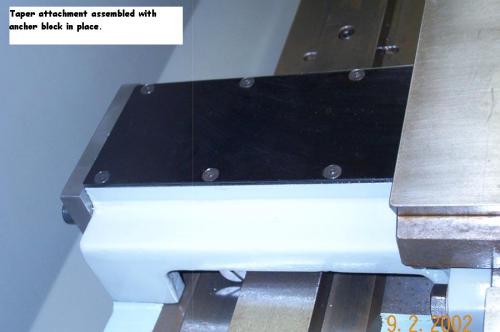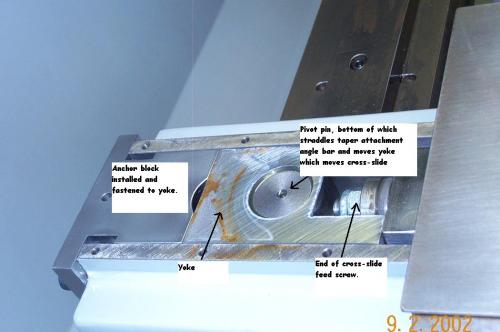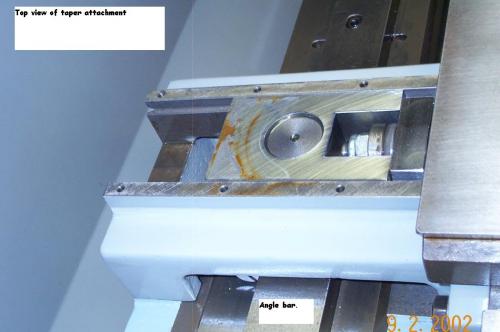Chris,
I filed this away years ago:
Home Machinist
Telescoping Taper Attachment Modification (Long)
Posted By: Dave Milosevich [San Pedro, PRC] <mailto:canddmil@pacbell.net?subject=Telescoping Taper Attachment Modification (Long)>
Date: Wednesday, 11 September 2002, at 9:29 p.m.
When I acquired the 15" Clausing-Colchester in the link below, I was looking forward to having a taper attachment available for use on demand. Though built in the mid 1980's, the machine had seen essentially no use when I purchased it in early 2001. So it was surprising when I had difficulty in simple turning tasks of hitting a specific diameter on the workpiece. Hooking a dial indicator to the cross slide revealed that the tool infeed travel varied as much as .004" with respect to the dial on the crossfeed handwheel. This just did not make sense. Backing the tool out by two or three complete revolutions before going back in an equal distance, plus depth of cut, would mitigate the problem somewhat. If the tool was not backed out at all at the end of a pass and only fed in the desired depth before beginning the next cut, the problem was also less evident. So there were ways to work around the problem when just turning. But when threading, the problem was a PITA.
What I discovered was that the telescoping taper attachment's components had clearances that were stacking up. All the play was not consistently removed when the crossfeed handwheel was turned in opposite directions in small (less than 2 or 3 complete revolutions) increments. Don't misunderstand - backlash was not two or three complete revolutions. The amount of handwheel rotation required to actually reverse the direction of cross slide travel was about .010". The problem was that it might be .010" one time and .008" or .012" the next. And backing out, say, .100" and returning to the desired setting did not make it more consistent.
Backlash is usually just the sum of the crossfeed screw/nut assembly and the screw/thrust bearing clearances. The addition of the taper attachment included the pivot/yoke, angle bar/straddle, and dovetail/casting assembly clearances in the mix. All manner of fiddling with gib, thrust bearing, and cross slide nut adjustments did little good. This may have worked itself out as wear allowed all of the components to settle more easily against one another when the various tensions and pressures were inverted upon cross slide reversals. But I've got stuff to do now and did not want to deal with it any longer.
The solution arrived at was to anchor the yoke to the taper attachment casting which is bolted to the carriage saddle. This eliminated all of the clearances between the moving taper attachment parts. To use the taper feature, the three cap screws and block are removed and the attachment works normally. The fix works great. Only a few thousandths rotation of the cross slide feed wheel beyond removing the backlash, enables repetition of the tool feed distance within a very few tenths. Backlash itself was reduced to less than .004".
Clicking on the link should take you to my first, modest attempt at standing up a web page with images. The various links there should show some photos of what I was trying to describe above.




I filed this away years ago:
Home Machinist
Telescoping Taper Attachment Modification (Long)
Posted By: Dave Milosevich [San Pedro, PRC] <mailto:canddmil@pacbell.net?subject=Telescoping Taper Attachment Modification (Long)>
Date: Wednesday, 11 September 2002, at 9:29 p.m.
When I acquired the 15" Clausing-Colchester in the link below, I was looking forward to having a taper attachment available for use on demand. Though built in the mid 1980's, the machine had seen essentially no use when I purchased it in early 2001. So it was surprising when I had difficulty in simple turning tasks of hitting a specific diameter on the workpiece. Hooking a dial indicator to the cross slide revealed that the tool infeed travel varied as much as .004" with respect to the dial on the crossfeed handwheel. This just did not make sense. Backing the tool out by two or three complete revolutions before going back in an equal distance, plus depth of cut, would mitigate the problem somewhat. If the tool was not backed out at all at the end of a pass and only fed in the desired depth before beginning the next cut, the problem was also less evident. So there were ways to work around the problem when just turning. But when threading, the problem was a PITA.
What I discovered was that the telescoping taper attachment's components had clearances that were stacking up. All the play was not consistently removed when the crossfeed handwheel was turned in opposite directions in small (less than 2 or 3 complete revolutions) increments. Don't misunderstand - backlash was not two or three complete revolutions. The amount of handwheel rotation required to actually reverse the direction of cross slide travel was about .010". The problem was that it might be .010" one time and .008" or .012" the next. And backing out, say, .100" and returning to the desired setting did not make it more consistent.
Backlash is usually just the sum of the crossfeed screw/nut assembly and the screw/thrust bearing clearances. The addition of the taper attachment included the pivot/yoke, angle bar/straddle, and dovetail/casting assembly clearances in the mix. All manner of fiddling with gib, thrust bearing, and cross slide nut adjustments did little good. This may have worked itself out as wear allowed all of the components to settle more easily against one another when the various tensions and pressures were inverted upon cross slide reversals. But I've got stuff to do now and did not want to deal with it any longer.
The solution arrived at was to anchor the yoke to the taper attachment casting which is bolted to the carriage saddle. This eliminated all of the clearances between the moving taper attachment parts. To use the taper feature, the three cap screws and block are removed and the attachment works normally. The fix works great. Only a few thousandths rotation of the cross slide feed wheel beyond removing the backlash, enables repetition of the tool feed distance within a very few tenths. Backlash itself was reduced to less than .004".
Clicking on the link should take you to my first, modest attempt at standing up a web page with images. The various links there should show some photos of what I was trying to describe above.
Andrew Mawson, proud to be a member of MetalworkingFun Forum since Oct 2013.




